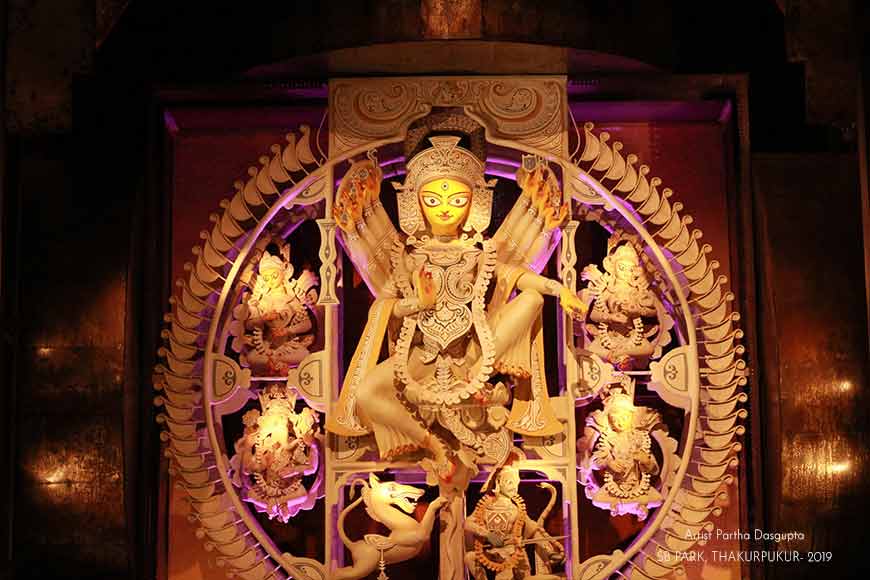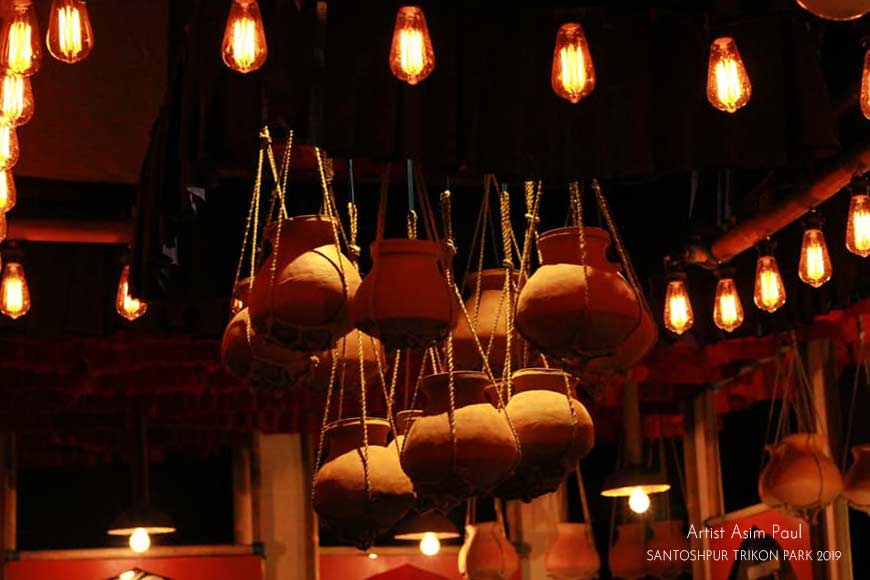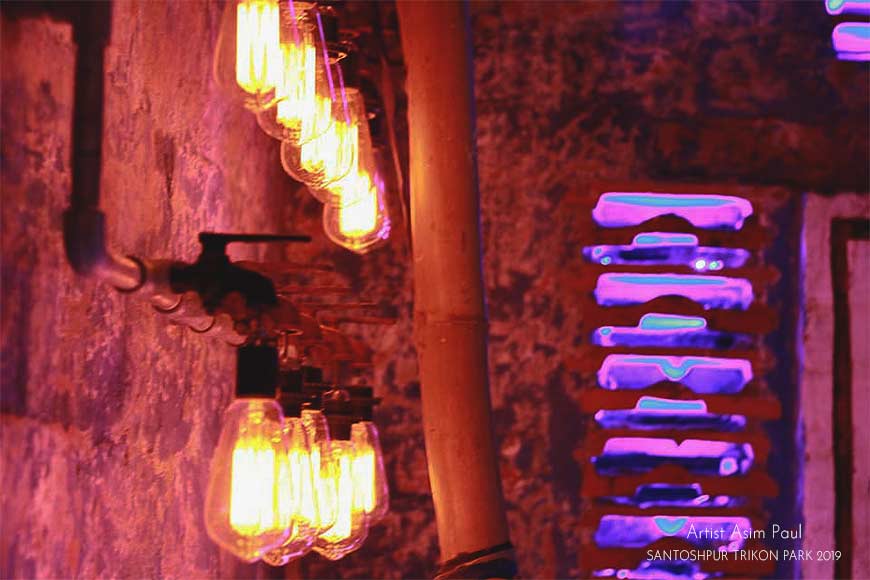AGOMONI -- How Street Installation Art became part and parcel of Modern Durga Puja

Street installations during Durga Puja have limited shelf life no doubt. Despite the sweat and time that goes into erecting them, they get pulled down within days. What then changed over the past decade, that lead to a complete paradigm shift from age-old tradition to mere imitation of Western ideas, reflected in innumerable street installations accompanying theme puja pandals? Stride of ‘modernism’ in art and literature had emerged in the West, to establish a quest for identity in the socio-political and economic arena. But in India, indigenous ethnicity never allowed to absorb ideas of the West without debating them. Though these days we often find our fragile enterprise, succumbing to an unmindful imitation and recapitulation of the West, or to equally thoughtless fanatic ideas and fundamentalism rooted in our own society.
However, intermingling of cultural aspects somehow helped in developing a concept of installation art in the Indian context, that opened a new spectrum of visual language. While in the West, conceptualisation and execution of such art, lay in application of self-conscious aesthetic outlook, Indian art scenario kept installation art in obscurity, along the periphery of fine arts. Idea of installation art is however found within age-old structure of religious tradition of the East that got re-articulated in identity and language of theme puja.

Earlier, the idol was placed in a niche, with a temporary structure providing a backdrop. Simple bhog offerings were sufficient to meet needs of religious customs. Gradually, festivals that were examples of living installation, like Jhulan, Charak, became part of our tradition. In the modern urban landscape, commodification and globalisation have hit puja pandals, altering their identity and re-orienting ritualistic space from personal to a public and interactive platform. Festivals have now turned into an exhibition of installation, rather than adhering to tradition and this shift is also viewed in art installations of pandals.
In the West, installation art is a direct reflection of a consumerist society, while in the East it has paved for expressions and artistic experimentation through modification of religious practice. Towards the end of 20th century, many Indian artists challenged traditional painting and sculpture. They sought to explore the space, where artwork was exhibited as an integral component of the work itself. This dramatic use of space signalled a radical change from more established art forms and subjects. Thus, puja pandals emerged as combination of tradition and new genre. It was a new way for both artists and viewers to interact with an artwork that had a contemporary twist.

The stride of post modernism struck the shores of India in 1990’s. Installation art dates back to the same period. Insurgence of globalization and changing market economy guided intellectual and artistic aspirations, affecting our mundane life and culture, though at times they lacked the finesse of modern art forms. This trend is all so apparent in one of the biggest festivals of Bengal --- Durga Puja. The journey of transformation from the courtyard of babus and zamindars to ‘Barowari’ or committee pujas, from a sanctified Thakurdalan, to huge street side pandals, created a new saga of changing market economy. Even, the genre of nascent visual representational pattern related to artistic ideas, gained popularity and transformed simple esoteric rituals into mass hysteria and consumerism. Pandals now embodied throbbing aspects of popular culture and attracted masses with association of trained artists. Intervention of art college groomed artists, changed the form of Goddess Durga from Khas Bangla to Art er Thakur and pandals represented thematic delegation. The aim and orientation altered to mass consumerism than of mystic traditional one.
However, this transformation did not happen in a day. The first grand worship of Goddess Durga in recorded history was in late 1500s. According to folklore, landlords or zamindars of Dinajpur and Malda, initiated the first Durga Puja in Bengal. Some say, Raja Kangshanarayan of Taherpur and Bhabananda Mazumdar of Nadia, organized the first Sharadiya or autumn Durga Puja in Bengal in 1606. It was an era, when Durga Puja was exclusively celebrated by wealthy Bengali Hindu families, who were either landowners or worked for the British. In 18th century, a new element was added to festivals, when distinguished British officers were invited to celebrate with Hindu families. The guests participated in festivities, but were not allowed to enter the sacred space inside the household, where the Durga idol was kept. Durga Puja gradually spread from households of rural zamindars, to urban spaces of Calcutta. Nonetheless it was restricted only to elite households.
In the last decade of the 18th century started the concept of Barwari Pujo. Twelve Brahmins established a committee, to organize their own Durga puja (Bindheswary) in Guptipara of Hooghly district, as some of them were denied entry into a household celebration. By the first decade of the 20th century, Barowari puja turned Sarbojonin. It was now open to all, with the entire para getting involved. Sarbojanin Durga puja is now what we call the Para puja.

Theme puja pandals started sending out social massages through installations. They focussed on artistic awareness, through representational approach. Introduction of social issues were cherished with artistic approach of the ceremonial act, which was transforming through economic limitation, popularity, need, co-ordination among public, workers, artist and organizers. Usually, themes are executed through various materials. Ritual and theme are incorporated in juxtaposing composition like gravitational force of the ritualistic belief and artistic modernization of aesthetic values of the environment. It is almost like vanishing of folk arts like Alpona and Rangoli, thanks to modern street art and painting. Be it the changes in the clay idol that now took to metal or fibre casting, chanting of mantra that gave way to modern music; theme oriented stage or platform and ritual based ‘mandapa’--- they all acted as exemplifiers of artistic intent. Even rural folklores made way for performance by folk artists within the pandals, be they Santhal dancers or tribal drummers.









